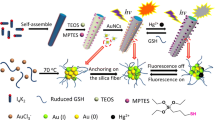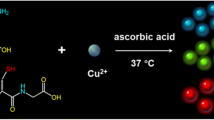Abstract
Luminescent copper nanoclusters (Cu NCs) are chosen to functionalize Ti3C2Tx MXene flakes to form a new kind of nanohybrid. It was applied to the determination of glutathione (GSH) via photoluminescence (PL). The Cu NCs and MXene flakes are in close contact, and the blue PL of the Cu NCs (with excitation/emission peaks at 380/425 nm) is quenched. The addition of GSH triggers the separation of the nanohybrid. This results in the recovery of PL. GSH also promotes the PL of Cu NCs via host-guest interactions. Thus, target recognition, corresponding signal output and further magnification are accomplished in a single step. Under optimum conditions, the nanohybrid can detect GSH in the 5.0 to 100 μM concentration range and with a 3.0 μM detection limit. The assay is very specific and shows high selectivity towards metal ions, small biomolecules, amino acids, and thiol containing molecules.

Luminescent copper nanoclusters are used to functionalize Ti3C2Tx MXene flakes, forming a nanohybrid, which is applied to detect glutathione. Target recognition, signal output and magnification are accomplished in a single step, resulting in high selectivity.




Similar content being viewed by others
References
Naguib M, Halim J, Lu J, Cook KM, Hultman L, Gogotsi Y, Barsoum MW (2013) New two-dimensional niobium and vanadium carbides as promising materials for Li-ion batteries. J Am Chem Soc 135:15966–15969
Huang K, Li Z, Lin J, Han G, Huang P (2018) Two-dimensional transition metal carbides and nitrides (MXenes) for biomedical applications. Chem Soc Rev 47:5109–5124
Dai C, Lin H, Xu G, Liu Z, Wu R, Chen Y (2017) Biocompatible 2D titanium carbide (MXenes) composite Nanosheets for pH-responsive MRI-guided tumor hyperthermia. Chem Mater 29:8637–8652
Luo Y, Chen G-F, Ding L, Chen X, Ding L-X, Wang H (2019) Efficient Electrocatalytic N2 fixation with MXene under ambient conditions. Joule 3:279–289
Xu B, Zhu M, Zhang W, Zhen X, Pei Z, Xue Q, Zhi C, Shi P (2016) Ultrathin MXene-micropattern-based field-effect transistor for probing neural activity. Adv Mater 28:3333–3339
Kim SJ, Koh H-J, Ren CE, Kwon O, Maleski K, Cho S-Y, Anasori B, Kim C-K, Choi Y-K, Kim J, Gogotsi Y, Jung H-T (2018) Metallic Ti3C2Tx MXene gas sensors with ultrahigh signal-to-noise ratio. ACS Nano 12:986–993
Wang F, Yang C, Duan M, Tang Y, Zhu J (2015) TiO2 nanoparticle modified organ-like Ti3C2 MXene nanocomposite encapsulating hemoglobin for a mediator-free biosensor with excellent performances. Biosens Bioelectron 74:1022–1028
Lorencova L, Bertok T, Filip J, Jerigova M, Velic D, Kasak P, Mahmoud KA, Tkac J (2018) Highly stable Ti3C2Tx (MXene)/Pt nanoparticles-modified glassy carbon electrode for H2O2 and small molecules sensing applications. Sensors Actuators B Chem 263:360–368
Lee E, VahidMohammadi A, Prorok BC, Yoon YS, Beidaghi M, Kim D-J (2017) Room temperature gas sensing of two-dimensional titanium carbide (MXene). ACS Appl Mater Interfaces 9:37184–37190
Zheng J, Wang B, ** Y, Weng B, Chen J (2019) Nanostructured MXene-based biomimetic enzymes for amperometric detection of superoxide anions from HepG2 cells. Microchim Acta 186:95
Gan X, Zhao H, Schirhagl R, Quan X (2018) Two-dimensional nanomaterial based sensors for heavy metal ions. Microchim Acta 185:478
Yao Q, Chen T, Yuan X, **e J (2018) Toward Total synthesis of Thiolate-protected metal Nanoclusters. Acc Chem Res 51:1338–1348
** R, Zeng C, Zhou M, Chen Y (2016) Atomically precise colloidal metal Nanoclusters and nanoparticles: fundamentals and opportunities. Chem Rev 116:10346–10413
Wang Z, Chen B, Rogach AL (2017) Synthesis, optical properties and applications of light-emitting copper nanoclusters. Nanoscale Horiz 2:135–146
**e J, Zheng Y, Ying JY (2009) Protein-directed synthesis of highly fluorescent gold Nanoclusters. J Am Chem Soc 131:888–889
Bai X, Xu S, Wang L (2018) Full-range pH stable au-clusters in Nanogel for confinement-enhanced emission and improved sulfide sensing in living cells. Anal Chem 90:3270–3275
Wu Z, ** R (2010) On the Ligand’s role in the fluorescence of gold Nanoclusters. Nano Lett 10:2568–2573
Wang Z, Chen B, Susha AS, Wang W, Reckmeier CJ, Chen R, Zhong H, Rogach AL (2016) All-copper Nanocluster based Down-conversion white light-emitting devices. Adv Sci 3:1600182
Wang Z, Susha AS, Chen B, Reckmeier C, Tomanec O, Zboril R, Zhong H, Rogach AL (2016) Poly(vinylpyrrolidone) supported copper nanoclusters: glutathione enhanced blue photoluminescence for application in phosphor converted light emitting devices. Nanoscale 8:7197–7202
Wang H, Wang Z, **ong Y, Kershaw SV, Li T, Wang Y, Zhai Y, Rogach AL (2019) Hydrogen peroxide assisted synthesis of highly luminescent sulfur quantum dots. Angew Chem Int Ed 58:7040–7044
Deng R, **e X, Vendrell M, Chang Y-T, Liu X (2011) Intracellular glutathione detection using MnO2-Nanosheet-modified Upconversion nanoparticles. J Am Chem Soc 133:20168–20171
Zhang X-L, Zheng C, Guo S-S, Li J, Yang H-H, Chen G (2014) Turn-on fluorescence sensor for intracellular imaging of glutathione using g-C3N4 Nanosheet–MnO2 Sandwich Nanocomposite. Anal Chem 86:3426–3434
He D, Yang X, He X, Wang K, Yang X, He X, Zou Z (2015) A sensitive turn-on fluorescent probe for intracellular imaging of glutathione using single-layer MnO2 nanosheet-quenched fluorescent carbon quantum dots. Chem Commun 51:14764–14767
Han F, Luo S, **e L, Zhu J, Wei W, Chen X, Liu F, Chen W, Zhao J, Dong L, Yu K, Zeng X, Rao F, Wang L, Huang Y (2019) Boosting the yield of MXene 2D sheets via a facile hydrothermal-assisted intercalation. ACS Appl Mater Interfaces 11:8443–8452
Tu S, Jiang Q, Zhang X, Alshareef HN (2018) Large dielectric constant enhancement in MXene Percolative polymer composites. ACS Nano 12:3369–3377
Y-e S, Luo S, Ji X, Liu F, Chen X, Huang Y, Dong L, Wang L (2017) Synthesis of ultra – stable copper nanoclusters and their potential application as a reversible thermometer. Dalton Trans 46:14251–14255
Wang Z, Y-e S, Yang X, **ong Y, Li Y, Chen B, Lai W-F, Rogach AL (2018) Water-soluble biocompatible copolymer Hypromellose grafted chitosan able to load exogenous agents and copper Nanoclusters with aggregation-induced emission. Adv Funct Mater 28:1802848
Wu Z, Liu J, Gao Y, Liu H, Li T, Zou H, Wang Z, Zhang K, Wang Y, Zhang H, Yang B (2015) Assembly-induced enhancement of cu Nanoclusters luminescence with Mechanochromic property. J Am Chem Soc 137:12906–12913
Zu F, Yan F, Bai Z, Xu J, Wang Y, Huang Y, Zhou X (2017) The quenching of the fluorescence of carbon dots: a review on mechanisms and applications. Microchim Acta 184:1899–1914
Chakraborty I, Pradeep T (2017) Atomically precise clusters of Noble metals: emerging link between atoms and nanoparticles. Chem Rev 117:8208–8271
Li Y, Deng Y, Zhou X, Hu J (2018) A label-free turn-on-off fluorescent sensor for the sensitive detection of cysteine via blocking the Ag+-enhancing glutathione-capped gold nanoclusters. Talanta 179:742–752
He J, Yan F, Kong D, Ye Q, Zhou X, Chen L (2016) Fluorescent probes for glutathione detection. Curr Org Chem 20:2718–2734
Chen W, Luo H, Liu X, Foley JW, Song X (2016) Broadly applicable strategy for the fluorescence based detection and differentiation of glutathione and cysteine/Homocysteine: demonstration in vitro and in vivo. Anal Chem 88:3638–3646
Bano D, Kumar V, Singh VK, Chandra S, Singh DK, Yadav PK, Talat M, Hasan SH (2019) A facile and simple strategy for the synthesis of label free carbon quantum dots from the latex of Euphorbia milii and its peroxidase-mimic activity for the naked eye detection of glutathione in a human blood serum. ACS Sustain Chem Eng 7:1923–1932
Acknowledgments
This work was financially supported by the National Natural Science Foundation of China (21804030), Natural Science Foundation of Guangdong Province (Grant No. 2018A030310420), Natural Science Foundation of Shenzhen University (Grant No. 2017004), Shenzhen Science and Technology Research Grant (Grant No. JCYJ20170818142354137).
Author information
Authors and Affiliations
Corresponding authors
Additional information
Publisher’s note
Springer Nature remains neutral with regard to jurisdictional claims in published maps and institutional affiliations.
Electronic supplementary material
ESM 1
(DOC 589 kb)
Rights and permissions
About this article
Cite this article
Shi, Ye., Han, F., **e, L. et al. A MXene of type Ti3C2Tx functionalized with copper nanoclusters for the fluorometric determination of glutathione. Microchim Acta 187, 38 (2020). https://doi.org/10.1007/s00604-019-4000-x
Received:
Accepted:
Published:
DOI: https://doi.org/10.1007/s00604-019-4000-x




